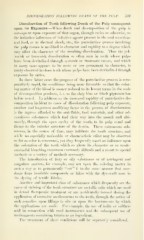Page 541 - My FlipBook
P. 541
DISCOLORATION FOLLOWING DEATH OF THE PULP. 539
Discoloration of Teeth follo^w^ing- Death of the Pulp consequent
upon its Exposure.—When death and deeonipusition of the pulp is
consequent upon exposure of that organ, throngli earies or otherwise, to
the irritative influences of infective agents present in the oral secretions
and food, or to thermal shock, etc., the pntrefactive process involving
the pulp tissues is modilied in character and rapidity to a degree which
may affect the character of the resulting discoloration. Thus the yel-
lowish or brownish discoloration so often seen in teeth whose pulps
have been devitalized through systemic or traumatic causes, and which
in many cases appears to be more or less permanent in character, is
rarely observed in those teeth whose pulps have been devitalized through
exposure by caries..
In these latter cases the progress of the putrefactive process is com-
paratively ra})id, the conditions being more favorable so that the color-
ing matter of the blood is sooner reduced to its lowest terms in the scale
of decomposition products, /. e. to the slaty blue or black pigmentation
before noted. In addition to the increased rapidity of putrefactive de-
coniposition incident to cases of discoloi'ation following pulp exposure,
another and ini])ortant modifying factor in the process of discoloration
is the ingress aflPorded to the oral fluids, food materials, and other ad-
ventitious substances which find their way into the mouth and ulti-
mately, through the o})en cavity of the tooth, to its pulp canal and
thence to the tubular structure of the dentin. These extraneous sub-
stances, in the course of time, may infiltrate tlie tooth stnicture, and
while no especially noticeable or characteristic effect may be observed
so far as color is concerned, yet they frequently exert an inflnence upon
the coloration of the tooth which so alters its. character as to render
successful bleaching treatment extremely difficult and a resort to special
methods or a variety of methods necessary.
The introduction of fatty or oily substances or of astringent and
coagulant matters, for example, may act upon the coloring matter in
such a way as to permanently " set " it in the same manner that mor-
dants form insoluble compounds or lakes with the dye-stufls used in
the dyeing of textile fabrics.
Another and important class of substances which frequently are the
cause of staining of the tooth structure are metallic salts which are used
in dental therapeutic treatment or are accidentally formed (hiring the
a])])lication of corrosive medicaments to the teeth, through the action of
such remedies npon fillings in xif^i or upon the instruments by which
the applications are made. For example, the use of iodin or sulfuric
acid in connection with steel instruments and the snbsequent use of
medicaments containing tannin as an ingredient.
The treatment of these conditions will be se})arately considered.


